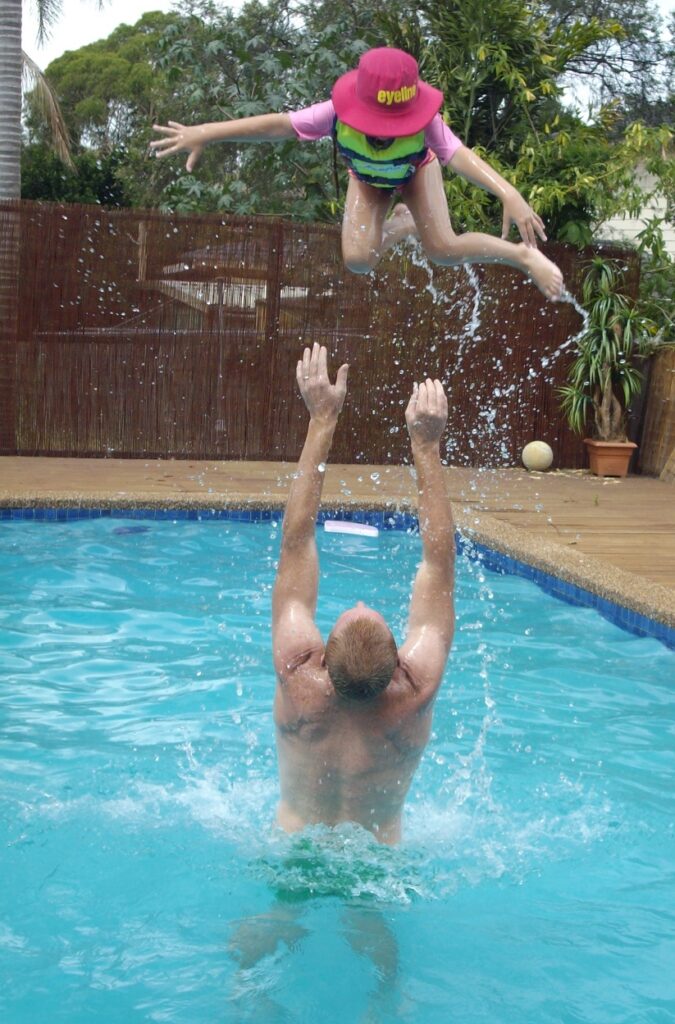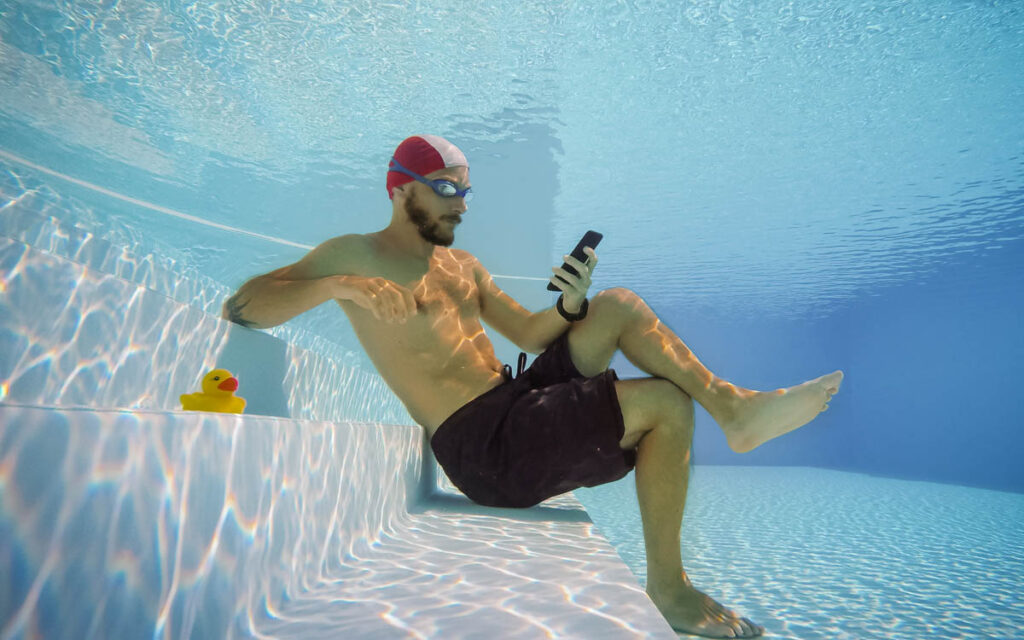
Why you should invite Dr Langelier to YOUR pool!
Pool water will always (try to) find its own water balance. The question is, will this be what you and your pool want or actually need? There can be unsuspecting actions going on as your pool water tries to get itself in balance. Actions that can make your pool uninviting at best and/or pump parts corroding away at worst.
So, let’s dive in and see what’s really going on here. There is a desire, indeed a need to get your pool water into balance and then keep it there. This will ensure your pool (always) looks inviting to dive right in and enjoy. In addition, you need the sanitation level correct, the mineral content correct, (pool water contains minerals no matter where your water comes from), and a few other goodies and often baddies, like phosphates.
So, to really help you and all other pool owners a certain Dr. W Langelier developed a complex formula way back in 1936, for the analytical control of anti-corrosion water treatment. This was aimed at the industrial market then; however, it was simplified in 1965 by Carrier of air conditioning fame and has since become very useful for all swimming pool owners as well.
Briefly, it can now tell with a good degree of confidence, whether your pool water is in balance or not, and if not, explain what you are seeing, going on.
One can have a long and lengthy discussion about the formula and the background however rather than blind you with more technical material than you need, let’s focus on the key factors.
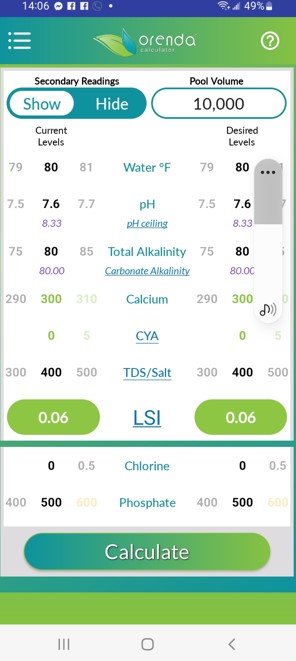
The Langelier Saturation Index (LSI) needs to be kept always in the range of -0.3 to + 0.3 for a well-balanced pool. You can ask your pool shop to calculate this for you every time you get a water test and make sure it along with all the other parameters they test, like pH, Chorine, Ca and TA, are recorded including the date. Then you can see your pool water chemistry trends and take action in advance of developments. This will save you money.
If you do your own tests at home with a test kit, you can enter the data on your smart app and get the results as well. Search for Orenda LSI on your smart app store and download it. (see image above)
The LSI index predicts the calcium carbonate stability in your pool water.
- LSI >+ 0.3, then water is supersaturated and tends to precipitate a scale layer inside the pool and filter equipment.
- LSI -0.3 to + 0.3 generally in balance with no significant activity.
- LSI <-0.3, then water is undersaturated and tends to dissolve solid CaC03 (Calcium Carbonate)
- The LSI index is temperature sensitive, and the higher the temperature of the (heated pool) the greater the LSI becomes. So, you need to determine pool water temperature along with, the Calcium Hardness, Total Alkalinity, Total Dissolved Solids, and any Cyanuric acid in your pool water. These factors are determined at your pool shop water test, automatically. If doing home testing you need a test kit that covers these points also, not just a basic test kit.
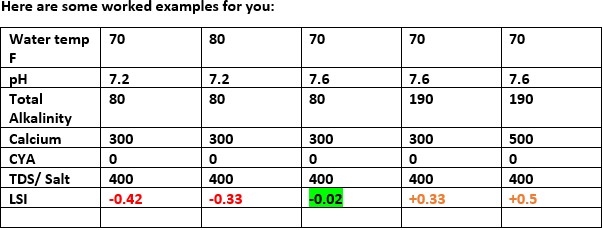
So, you can see by making only a few changes here (Water temp, pH, TA, Ca) the LSI varies. In red the readings are too low or in orange too high, in green, acceptable.
By tracking the LSI over time and with the other factors also recorded, you can discover your pool’s trends, as the seasons change, or bather load etc. Then know what to do in advance of the LSI getting too low or too high and make adjustments to the chemistry. This will usually save you money as the corrections are less, and thus use fewer chemicals to keep in balance etc.
In the above example take column 3, the green result. So if we see the TA starting to raise we know that the LSI will also increase, all else being the same. Then we can take steps to reduce TA before it gets so high as to cause the LSI to go above +0.3. (This can be affected by adding some acid to your pool) And if you see the TA heading towards 120, then the LSI will be +0.32 already, so its time to add some acid to bring it back, rather than waiting till its at 190 (in examples above) and having to add a lot more acid.
This is why testing your pool on regular basis (weekly summer, monthly winter) is so helpful once the LSI is known. Then you can be Pro-Active.
What does scaling mean? (LSI greater than +0.3) This means that calcium carbonate is deposited (dust, powder) on the pool surfaces, inc fittings, plumbing, and filtration equipment. Naturally, the higher the number the more of this scaling occurs and it can be very noticeable, as a fine white chalky like powder. (see image below)
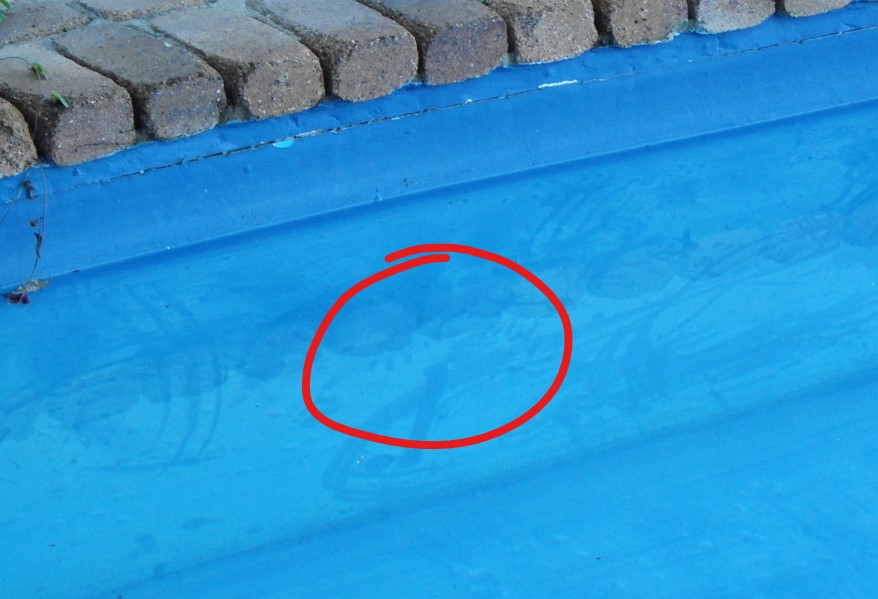
The pool water may look cloudy – murky as well. If you run your fingers across the surface, you can see the finger lines on the surface, and there may be color pick up even, as the scaling is quite abrasive. The pool water vacuum units may have a powder or color pickup also as they travel across the surfaces. There can be damage and build-up within the pump units and pipes leading to reduced flow and added work for pump motors.
Thus it is very desirable to not let this happen, as once it has taken hold, getting the scale off some surfaces can be quite difficult and the damage may be done already.
What does dissolving (corrosion) mean? (LSI less than -0.3) If your pool is in this state then the pool water will seek out Calcium Carbonate (CaCO3) to rebalance it back to 0. So where will it get the CaCo3 from? It will start with any cement surfaces in your pool, inc Marcite, Pebble Tec tile grout, and plasters in general. They will be etched away before your very eyes, making a rough, friable, soft surface, so that algae take hold. Replacement is needed. Oh, I have a fiberglass or liner pool, then you need to look at the surfaces and you may well find a degradation going on. Also, in the plastic pipework too. Meaning shorter life than expected. Water STOPS AT NOTHING to find balance. So don’t think you and your pool are immune from the ravages of a low LSI.
Important: Today if ALL your readings are fine, this does not mean they were fine and in balance yesterday nor tomorrow. They can be out of balance for days or weeks and the damage is done. Now you will pay for it. Hence the need to do regular tests inc LSI and record the results so you can easily see them. Your pool needs to be in LSI Balance year-round for worry-free pool chemistry.
A good supplier of pool water test kits is Taylors. See here https://www.taylortechnologies.com
Suggest the 9-way test kit is the most useful
And make sure whoever does your pool water testing knows their chemistry very well!
Here is a more detailed article from Orenda on LSI, I suggest you check it out.
https://blog.orendatech.com/calcium-misunderstood-chemistry
